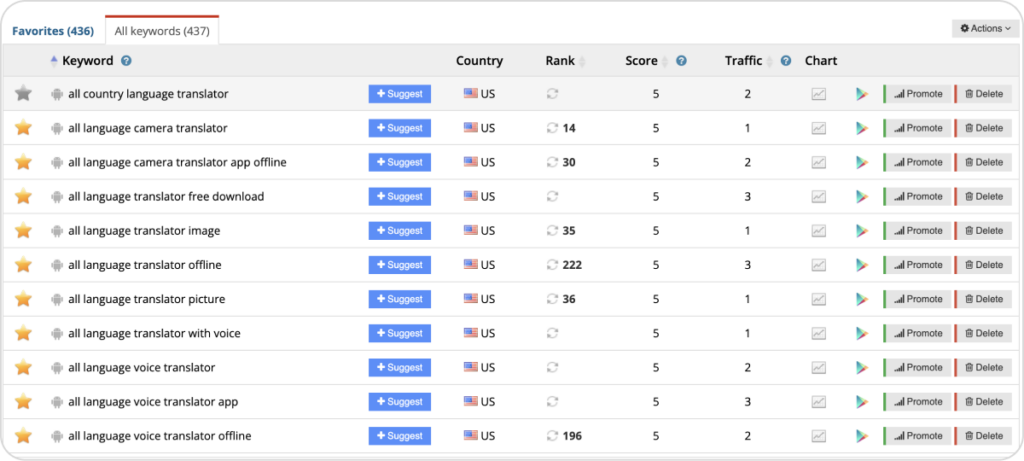In the ever-evolving landscape of app stores, App Store Optimization (ASO) has played a pivotal role in helping app developers increase their visibility, attract users, and drive downloads. However, as we look towards the future, it’s important to recognize that the traditional approaches to ASO may face new challenges and require adaptation to remain effective. In this article, we explore the question: Why will ASO not work in 2024, and how not to screw up with ASO in the future?
- Why is ASO so important for mobile apps in 2024?
- The main mistakes that lead to non-working ASO
- How do you avoid this mistake, which makes ASO less efficient than it could be?
Why is ASO so important for mobile apps in 2024?
First of all, let’s discuss what ASO is. ASO is a process of improving an app’s visibility and user appeal in the app stores and increasing app conversion rates to get more downloads. So when you optimize the app in the first steps, you mostly work with text and visual optimization.
One of the aims of ASO is to increase the app positions for search requests on Google Play or AppStore, while the other is a high click-through rate, or so-called CTR. To optimize for high CTR, it is needed to convince organic users to click on your app store listing once they find it and see it on the store. Typical CTR optimization includes your app name, app title, app icon, app screenshots, and app ratings.
You may ask why ASO is so important for mobile apps published on Google Play and AppStore? The answer is pretty simple, with the number of available apps now on Google Play and AppStore the competitiveness is extremely high, and more and more efforts are needed to attract organic users and make your application to be found by these users both in the search list and in different kinds of charts. This is also confirmed by the data from Statista showing how many apps are now on two main stores, over 3.55 million mobile apps on Google Play and 1.6 million on AppStore.
It is widely known that the main goal for any app publisher is to get more downloads and grow the user base and App Store optimization is the right way to achieve this. Here are some main advantages of app optimization:
- Improving app visibility and app positions in the search list.
Text app optimization influences the indexation process and the app positions for search requests on both stores. The way you added the keywords to the app name, title, and description will determine how successfully the app will get into the search list for the keywords.
- Getting downloads by relevant users and increasing the number of organic users.
It is important for the app to be found and then downloaded by the users who are looking exactly for this type of app, as it influences the conversion rates. App Store Optimization directly influences the amount of organic traffic your application gets as
- Text optimization influences the indexation process and the app positions for search requests on both Stores
- While visual optimization already has an impact on the way the application listing converts view to download.
- Increase app revenue and conversion rates
There are various ways to monetize your apps, such as in-app ads, in-app purchases, and subscription models. As a result, many of you may decide to run ads to bring in more users and, thus, more revenue. But if your app store listing page isn’t converting and convincing users to download your app, your ad spend will be wasted. Remember, app store optimization involves conversion rate optimization and getting people to click through and download the app.
The main mistakes that lead to non-working ASO
1. You do not create the strategy for App Store Optimization
From our experience, most app developers and publishers do not think about optimization at the stage of app development and try to postpone this process as much as possible to the app release. But that is a completely wrong approach. I would recommend starting to work with ASO when you start to develop the app and trying to analyze all the details about the niche you are going to enter even before. But what is more important is that it is extremely important to create a strategy for your app optimization and plan all the steps you are going to follow on the way.
2. You do not work with a keyword cloud
Basically, keyword research is the first step you, as an app developer, must take before creating the text and proceeding with optimization. But many developers and marketers are making the same common mistakes here. One of them is targeting mostly high-volume keywords, not working with keyword suggestions and long-tail keywords, and in general, targeting too few keywords for the project—let’s say, less than 50.
3. You do not localize the app
App localization refers to the process of adapting the interface and functionality of a mobile application to suit foreign language markets, and of course, this gives the app the possibility of getting more downloads worldwide. Working on a daily basis with different types of apps, we can say that most app developers do not localize their apps for other markets, thinking that if the app itself is not translated, there is no sense in localization. Of course, for the best results in organic growth, the app itself should be translated to meet the user’s expectations, but before or in the process of content translation, you should start working with localization for the countries popular in your vertical, to get a sense of where the app may be popular.
4. You optimize your app only once
Have you ever thought about how often it is necessary to change something in visual or text optimization? If you thought that doing this one time when you launch an app is completely enough, we can say that it was a mistake. Some developers research keywords and make changes, but only once. For a few apps, the first set of changes improves downloads, but for most, it won’t because App Store optimization is an iterative process.
This mistake is prevalent and costs developers a lot of potential downloads. It is, however, easy to fix. For App Store Optimization to work, you’ll need to try different things until you know what works, and then continue to optimize that. A simple way to iterate over ASO is to plan three different keyword sets and try each for about four weeks. After you’ve gone through all sets, take the parts from each that worked best, and double down on the keywords that worked while removing the ones that didn’t.
A keyword set is metadata that works with a specific theme of keywords. For example, if you have a translation app, one keyword set can revolve around the template of “translate into (language)” (ex. “translate into Spanish”). Another can be “(language) into (another language)” (ex. “Spanish into English”).
5. You use the same strategy for Google Play and AppStore Optimization
The main assets we work with in optimization are texts and visuals, but have you ever compared the ASO process for two main mobile markets? If not, we can say that Google Play and AppStore work in completely different ways, as is clearly observed in App store optimization.
Here are the main differences between these two stores in terms of optimization.
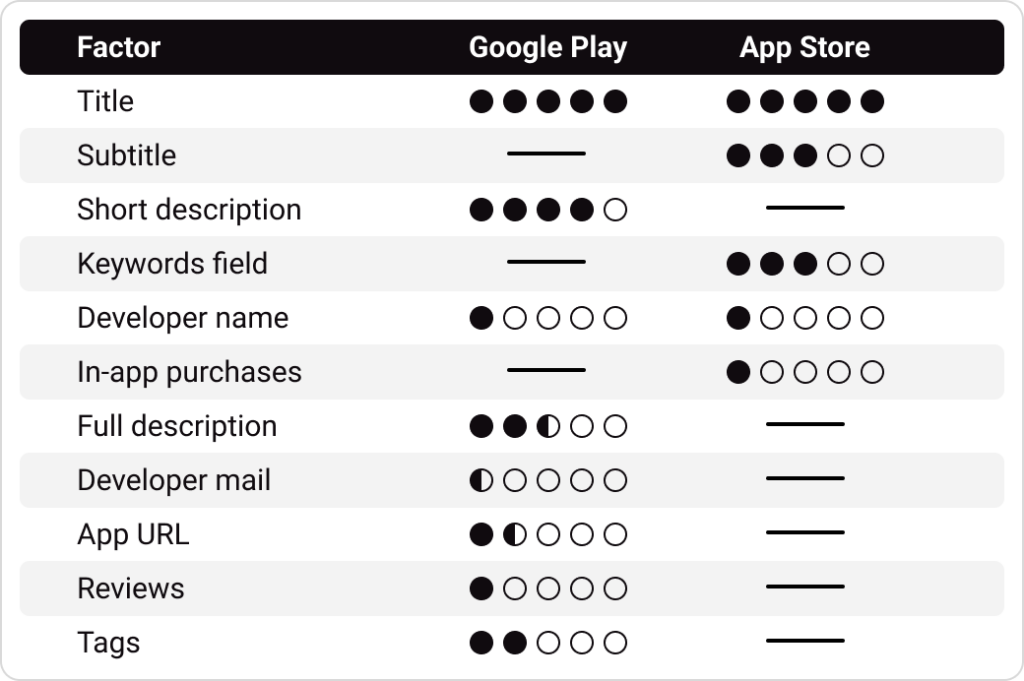
As we can see from the table provided, Google Play and AppStore check completely different fields to index the app for search requests. For example, while for Google Play app description is one of the main fields where a lot of keywords may be added due to the length of 4 000 characters, for AppStore the description has no weight and is used only to mention the app’s functionality and advantages in comparison to other apps.
All these nuances should be paid attention to when you work with both stores simultaneously or start to work with one of the stores for the first time.
6. You do not try increasing the app positions for keywords after ASO is done
As we have discussed, the main aim of ASO is to increase conversion rates and the number of organic users. One of the main sources of app organic traffic is the installs from searches made by users who look for the app with any search request. By the way, this source of traffic is considered the biggest one in both stores.
So after you optimized the app, the best possible result achieved is, of course, the indexation for keywords, especially if the positions are quite high. But not in all cases can the app achieve top ranks for search requests, especially if they are competitive, and in such cases, developers are forced to look for additional tools after optimization is done. One such tool is keyword promotion, which is done with the help of keyword-targeted installs. First of all, let’s discuss what keyword promotion is. It is a process of app positions increasing in the search list for a particular search request. The main aim of keyword promotion is to get higher positions for keywords, which makes an app more noticeable and visible for organic users, which increases the app’s chances of getting more installs from the search.
This type of promotion is conducted in the following way: the app is optimized and gets into the index, so after this, you can set up the campaign at Keyapp. Your app is found in the store for the search request and downloaded from the search list. In such a way, the store algorithm understands that the application is relevant for the search request looked for, gets installs for it, and the algorithm increases the positions in the list, making the application more visible. When the application gets at least to the top 5, it can start to get organic installs from the search request.
To start the keyword promotion, it is needed:
- to optimize app texts and visuals
- work out the app rating and reviews
- check if the app is in the index for the keywords you would like to promote it for (so the app should be in the top 250 for the search requests).
By the way, do not forget that you can check your app indexation for keywords completely for free using the Keyapp platform. There are no limitations on the number of requests or countries you can work with.
At the same time, keyword promotion needs the right strategy to be chosen, as well as ASO depending on the store you work with. We have talked a lot about the differences between the stores and how keyword promotion is conducted using different approaches depending on the app store, but it is important to pay attention one more time to the general recommendations, which can help you create the strategy for your app keywords boosting.

How do you avoid this mistake, which makes ASO less efficient than it could be?
- Analyze the app market and the niche you are going to enter with your application
That may include the analysis of top charts and top categories. For example, if you have a game, it is completely logical to analyze such charts as top free games, top paid games, popular games, best new games, etc. In such a way, you will be able to determine what type is popular now in a particular niche and what trends may be followed.
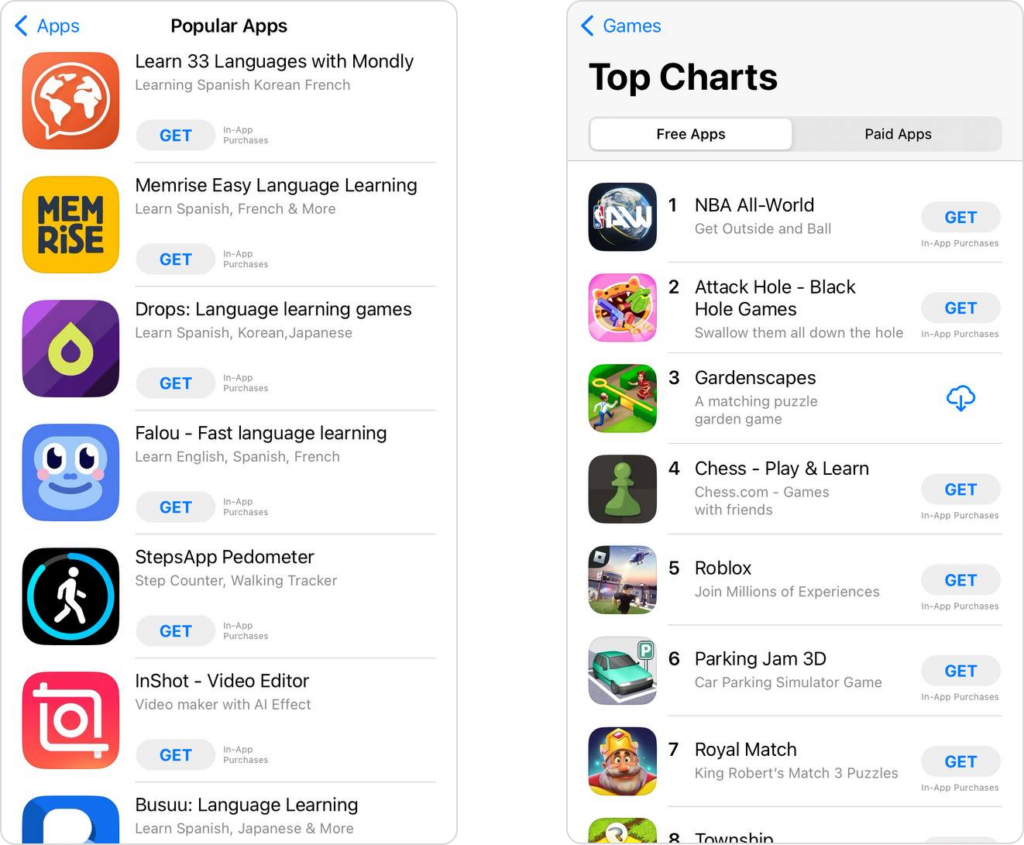
As an example, let’s imagine that you have a development studio and would like to create an application, but you do not have any particular preferences in the niche; you just want to have an app in a popular category. Following the recommendations, you can just go to App Store and enter the chart “Popular apps”. On the screen, you may see an example that gives an understanding that now the most popular apps in the US AppStore are language and photo tools.
- Analyze your competitors
If you have already decided which type of app you are going to develop, conduct a profound competitor analysis. This is needed both for visual and text optimization. The competitor’s analysis, as well as analysis of top-ranking apps in your category, will help you understand how they work with the app, update it and implement changes to the visuals, the lexical field, the keywords used, etc. It is important to do so to be in line with what users are expecting and how apps are positioned for this sector, so that you can identify good practice and implement it in your app or game.By the way, do not forget to use all the possible modern tools to analyze your niche and competitors, including AI. Read our article to find out how to apply AI and ChatGPT in ASO.
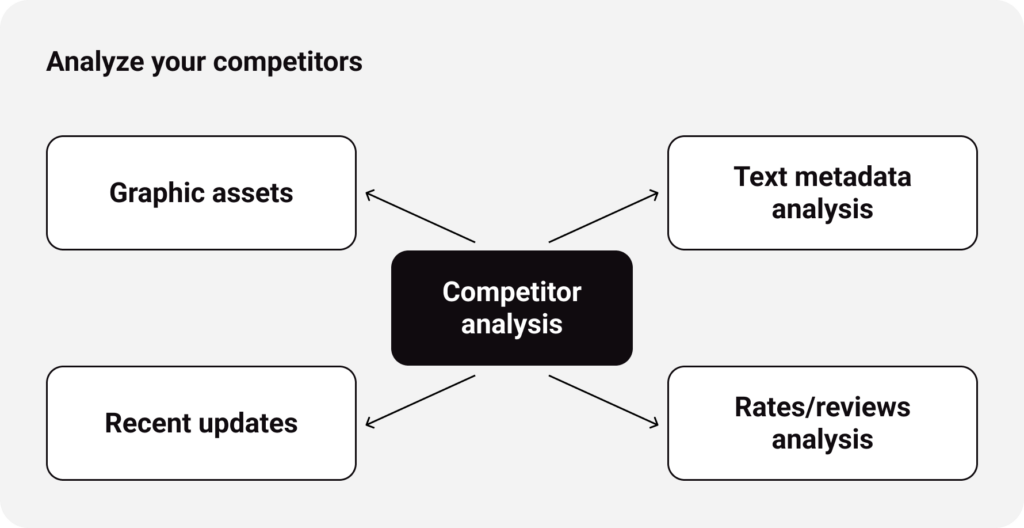
- Analyze trends in visual optimization
Of course, for different categories and types of apps/games, there may be different trends, but in most cases, if the app has a lot of competitors, it is easy to follow common trends used in visual optimization. I would like to show an example:
In the screenshot above, we tried to look for translation apps in the US and noticed a common thing that in most cases, all the developers are trying to use blue and dark blue in icon optimization (maybe that is connected with the colors used by the most popular translator by Google, which is known by most users and close to them). So basically, this may already be a trend in icon optimization. But it is even more clearly observed in countries that differ from the US and Europe, like Asia, and we will talk about this further.
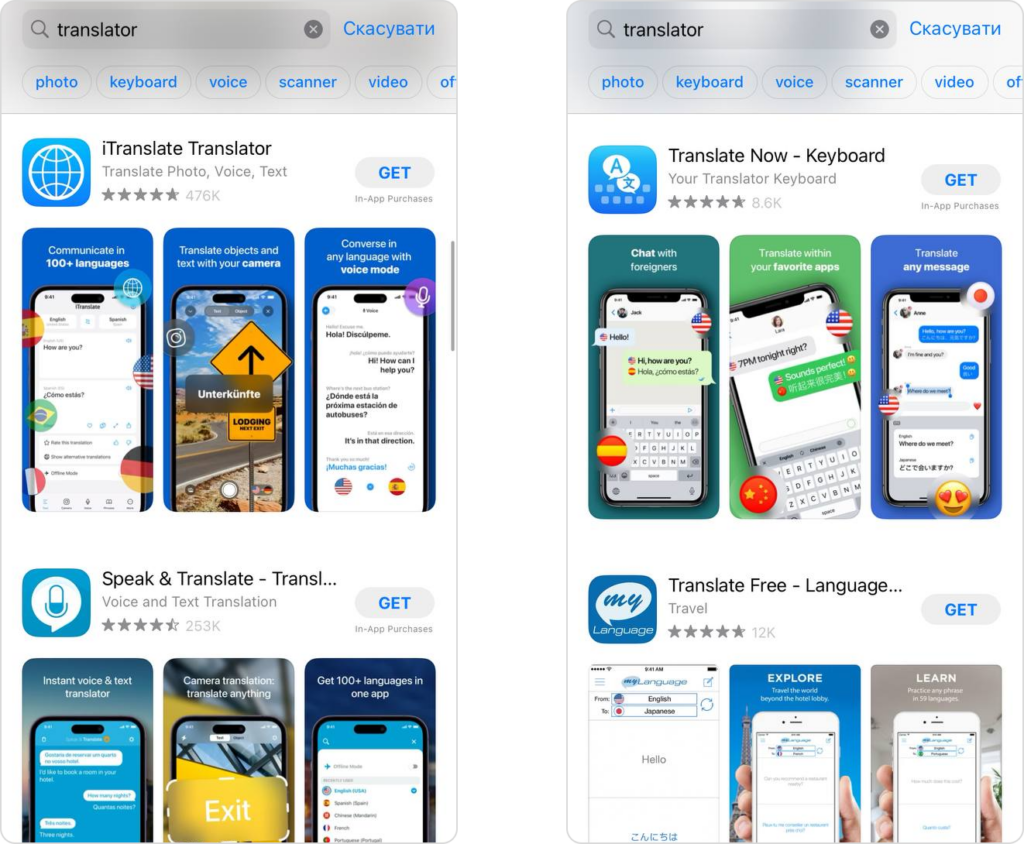
- Work with keyword cloud optimization on a permanent basis.
Add more and more search terms to your keyword list. In such a way, you will be able to follow all the changes in app positions as well as explore more new keywords with a good popularity score. Usually, the keyword for the app from the popular category may consist of 200-250 requests min.
Try to get as many keywords as possible by brainstorming, analyzing the competitors, and looking for suggestions on the store. By the way, with the last point, Keyapp ASO tools may help as well as any other services which have the functions of suggestions from GP or AP
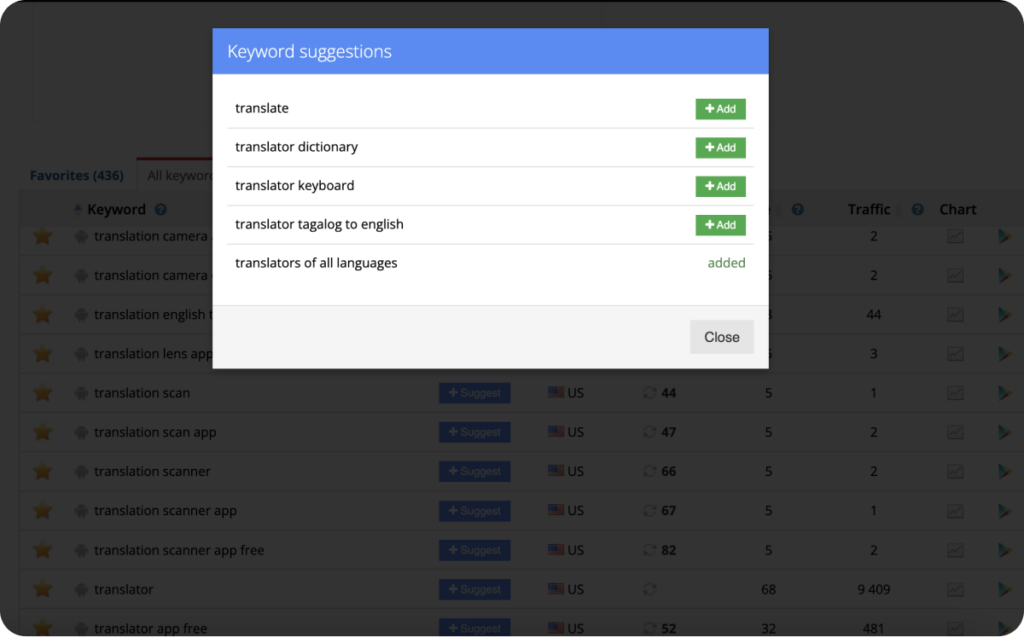
- Pay attention not only to the keywords with high popularity in your research.
When you use any ASO tool to check the keyword popularity and see high numbers, you believe that these keywords may only bring you organic traffic as they are used by users more often. That’s true, keywords with high popularity scores are used more often by users in the search for stores, but the competitiveness for them is higher as well, so it may be even more difficult to get into the index. Do not forget that long-tailed keywords of low popularity may bring users from the search as well, although occupying top ranks for such keywords is much more accessible both with ASO and keyword promotion.
All the processes conducted, both with keyword cloud and text optimization give the chance for the app to be indexed for keywords so as to be seen by organic users in the list of apps for search requests.
Here are some tips for app localization:
- Treat localization as a separate optimization process. You should do keyword research for the target country, considering this is a completely new keyword cloud. Try to define exactly which keywords are popular in your vertical as well as try to get visibility on all the local keywords, not just do a blind translation of the texts you have created in English or in your native language.
- Localize the graphics for the local market as well. As for the graphic assets, remember that they are user-facing, so try to adapt all maps, calendars, and other elements that will make the users feel that this app has been developed correctly for them. The same may be applied to the characters you use on the screenshots/icon as with these screenshots, where for the US and Japan different models are used. Besides, it is important to translate all the phrases you have on icons, screenshots, or in promo videos to the local language as well.

Summary
The App Store Optimization process is extremely important for your application’s success. Without an effective strategy, your application will remain unseen on the respective app stores you work with. At the same time, ASO influences not only the app visibility within the Google Play or AppStore but the app conversion and install rates as well. Summing up the main mistakes you may do as an app developer or marketer optimizing the application are:
- You optimize the app blindly without creating any strategy
- You do not work with a keyword cloud
- You do work with localization (or just create the blind translation of the app texts)
- You do not do iterations
- You apply the same strategy to Google Play and AppStore
- You rely only on organic position increases without using keyword promotion
Be attentive and apply all the possible tools to make your app visible and noticeable for organic users, and your application will surely reach success and a lot of organic traffic!



